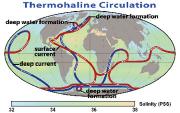Radio Program
Our regular Science and the SeaTM radio program presents marine science topics in an engaging two-minute story format. Our script writers gather ideas for the radio program from the University of Texas Marine Science Institute's researchers and from our very popular college class, Introduction to Oceanography, which we teach to hundreds of non-science majors at The University of Texas at Austin every year. Our radio programs are distributed at to commercial and public radio stations across the country.
The Amazon River nurtures a bounty of life -- the creatures that inhabit its waters, and the world’s largest rain forest around it. It also nurtures life when it empties into the Atlantic Ocean -- a bounty of microscopic plants that may play a role in regulating Earth’s climate.
The plants are known as phytoplankton, and they’re found in the top layers of all the world’s oceans. In recent years, scientists have been studying the role they play in regulating Earth’s climate.
When European explorer John Cabot neared the coast of Newfoundland in 1497, he saw so many fish churning the waters that you could practically walk on them. And for the next five centuries, European and American fleets scooped up those fish by the shipful: herring, halibut, haddock, and others, but mostly Atlantic cod.
They found this bounty in the Grand Banks, one of the most storied regions of the Atlantic Ocean.
The law of the jungle applies to the oceans just as much as the land: It’s eat or get eaten. And the difference often depends on one factor: speed. The creatures that are fast enough catch another meal -- or keep themselves from getting caught.
The oceans are full of speedy fish. The blue shark can zip along at a good 25 miles an hour, and perhaps faster. A tuna can clock in at around 30 miles an hour, while the dolphinfish might top out at 50.
The deepest spot in the Atlantic isn’t way out in the middle of the ocean, as you might expect it to be. Instead, it’s close to the edge -- a narrow canyon north of Puerto Rico known as the Puerto Rico Trench. A long segment of it bottoms out at a depth of more than five miles.
Trenches like these are quite common in the Pacific. In fact, the deepest point in all the oceans is the Mariana Trench, near Japan, with a depth of more than seven miles. But there are only two trenches in all the Atlantic.
Just about everything in the oceans is hunter, hunted, or both. But in the early 20th century, a hunter in the Atlantic turned a fish in the Pacific into one of the most hunted on the planet.
The hunter was the German U-boat. The fishing industry on the East Coast shut down as boats stayed in port to avoid the submarines. So a hungry nation looked to the Pacific Ocean. And there, the fleets brought in a staggering bounty of Pacific sardines.
NEWSREEL: A brilliance of 500 Suns lights hundreds of miles of the Pacific, and the force of a million tons of TNT is released. 15 seconds later, the light is still unbearable.
The nuclear bomb known as Bravo was the most powerful ever exploded by the United States. On March 1st, 1954, the 15-megaton weapon vaporized three islands in the western Pacific. They were part of Bikini atoll -- a ring of islands enclosing a lagoon that’s as big as Chicago. The blast gouged a crater more than a mile wide and 250 feet deep.
Anemones are some of the most beautiful creatures in the sea. Masses of tentacles atop their bodies look like flower petals, waving gently in the currents. And they group together in colonies, spreading color across the ocean floor.
But the tranquil view can be misleading. Colonies can include “warriors” whose job is to keep other colonies from encroaching on their turf. As a result, colonies are separated by narrow strips of open ground -- underwater demilitarized zones.
Like wine, ocean water has its own vintage — in essence, the date it was bottled. Marine scientists determine the vintage by measuring the water’s chemistry. The oldest water mass in the oceans may be almost a thousand years old.
It may be surprising to hear that not all ocean water is alike. The oceans consist of great masses of water. Each mass is determined by its temperature and salinity. It begins to age after it loses contact with the surface.
Scientists determine the age of a water mass by measuring its chemistry.
On warm summer days, the waters around Antarctica can explode in a feeding frenzy. Whales leap from the water, penguins plunge in like black-and-white torpedoes, and birds hover by the thousands. The cause of all this activity is a small creature that’s one of the most important food sources in the oceans: krill.
A new Mars rover is about ready to study an alien landscape. Instead of cold, orange, and dusty, though, this landscape is cold, black, and sludgy — the bottom of Monterey Bay off the coast of California.
The rover is called the Benthic Rover — benthic meaning bottom of the ocean. It’s one of five experiments that’ll be supported by MARS -- the Monterey Accelerated Research System.


